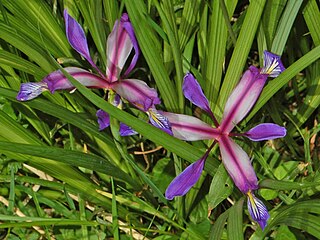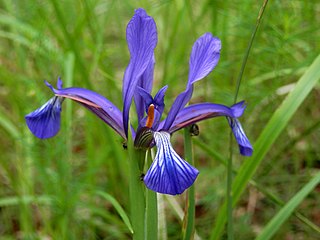
Iris spuria is a species of the genus Iris, part of the subgenus Limniris and the series Spuriae. It is a rhizomatous perennial plant, from Europe, Asia and Africa. It has purple or lilac flowers, and slender, elongated leaves. It is widely cultivated as an ornamental plant in temperate regions and hybridized for use in the garden. It has several subspecies; Iris spuria subsp. carthaliniae B.Mathew, Iris spuria subsp. demetrii B.Mathew, Iris spuria subsp. maritima (Dykes) P.Fourn. and Iris spuria subsp. musulmanica (Fomin) Takht. It used to have 3 other subspecies, which have now been re-classified as separate species; Iris spuria subsp. halophila, Iris spuria ssp. sogdiana and Iris spuria subsp. notha . It has many common names including 'blue iris', 'spurious iris' and 'bastard iris'.

Iris graminea is a species of flowering plant belonging to the subgenus Limniris of the genus Iris, in particular the series Spuriae. It is a rhizomatous perennial, with purple or violet blue flowers almost hidden by narrow, grass-like leaves, and a plum scented fragrance. It is cultivated as an ornamental plant in temperate regions. It has several common names, including grass-leaved flag, grass leaved iris, plum iris and plum tart iris. This species naturally occurs in the southern half of Europe, from Spain and France in the West to Russia and the Caucasus in the East.
Iris farreri is a beardless iris in the genus Iris, in the subgenus Limniris and in the series Tenuifoliae of the genus. It is a rhizomatous herbaceous perennial, from China. It has grey-green leaves, long stem and 1 or 2 violet, lilac or light blue flowers. It has undergone several changes of name and series, before being left as Iris farreri.
Iris kerneriana is a species in the genus Iris, it is also in the subgenus Limniris and in the series Spuriae. It is a small rhizomatous perennial plant, with fragrant, yellow flowers from Turkey. It is cultivated as an ornamental plant in temperate regions and known as Kerner Iris or Kerner's Iris.

Iris halophila is a species in the genus Iris, it is also in the subgenus Limniris and in series Spuriae. It is a rhizomatous perennial plant, with yellow, white or violet flowers. It is cultivated as an ornamental plant in temperate regions. It comes from a wide range from eastern Europe to China in Asia. It was known for a long while as a subspecies of Iris spuria, before being treated as a separate species in its own right.
Iris ludwigii, with the common name Ludwig iris, is a species in the genus Iris. It is also in the subgenus Iris subg. Limniris and in the series Spuriae. It is a rhizomatous perennial plant with violet-blue flowers. It is native to the Altai Mountains in Central Asia, where Russia, China, Mongolia, and Kazakhstan meet. It is cultivated as an ornamental plant in temperate regions.
Iris halophila var. sogdiana is a species in the genus Iris, it is also in the subgenus Limniris and in series Spuriae. It is a variety of Iris halophila. It was once a species in its own right as Iris sogdiana, before being re-classified as a synonym of Iris halophila, but it has been re-classed again as a variant of Iris halophila. It is a rhizomatous perennial plant, with blue-violet flowers. It is cultivated as an ornamental plant in temperate regions.

Iris notha is a species in the genus Iris, it is also in the subgenus Limniris and series Spuriae. It is a rhizomatous perennial with deep blue or violet flowers from the Caucasus region. It is cultivated as an ornamental plant in temperate regions. It was once Iris spuria subsp. notha, and can often be found under that name. It has the common name of fake iris or mimic iris in Russia.

Iris pontica is a species in the genus Iris, it is also in the subgenus Limniris and in series Spuriae. It is a dwarf rhizomatous perennial plant from eastern Europe, the Causcasus region and Russia, with a short stem and violet-blue and white flowers. It is cultivated as an ornamental plant in temperate regions.
Iris pseudonotha is a species in the genus Iris, it is also in the subgenus Limniris and in the series Spuriae. It is a rhizomatous perennial plant, from the Caucasus region, with lilac and yellow flowers. It is commonly known as Lozhnonenastoyaschy Iris in Russia. It is cultivated as an ornamental plant in temperate regions.

Iris sintenisii is a species in the genus Iris, it is also in the subgenus Limniris and in series Spuriae, with tall thin stems, violet-blue flowers and long grass-like leaves. It is a rhizomatous perennial plant, from grass meadows parts of Europe, Russia, and Turkey. It is cultivated as an ornamental plant in temperate regions.
Iris brandzae is a species in the genus Iris, it is also in the subgenus Limniris and in series Spuriae. It is a rhizomatous perennial plant, originally from Romania with violet and white flowers. It was once thought to be a subspecies of Iris sintenisii, but now classified as a separate species. It is also called Iris Brandzy or Prodan Iris in Russia. It is cultivated as an ornamental plant in temperate regions.

Iris spuria subsp. carthaliniae is a species in the genus Iris, it is also in the subgenus of Limniris and in the series Spuriae. It is a subspecies of Iris spuria, a rhizomatous perennial plant, from the Caucasus region, it is a tall iris with sky blue or white flowers. It was originally described by Fomin, as a separate species before Brian Mathew in 1981, added it to Iris spuria as one of its many subspecies. It is cultivated as an ornamental plant in temperate regions.
Iris spuria subsp. demetrii is a species of the genus Iris, part of a subgenus series known as Iris subg. Limniris and in the series Iris ser. Spuriae. It is a subspecies of Iris spuria, a rhizomatous perennial plant, from the Caucasus region, with blue-violet flowers. It is commonly known as Dimitry iris in Russia. It is cultivated as an ornamental plant in temperate regions.

Iris spuria subsp. maritima is a species of the genus Iris, part of a subgenus series known as Iris subg. Limniris and in the series Iris ser. Spuriae. It is a subspecies of Iris spuria, a beardless, rhizomatous perennial plant, from coastal regions Europe and north Africa with deep blue-violet flowers.
Iris spuria subsp. musulmanica is a species of the genus Iris, part of a subgenus known as Limniris and in the series Spuriae. It is a subspecies of Iris spuria and is a rhizomatous perennial plant, from Armenia, Azerbaijan, Iran and Turkey in Asia with flowers in various shades of blue, but there are rare white forms. They have a yellow centre and darker veining. It has the common name of 'Muslim iris'. It is cultivated as an ornamental plant in temperate regions.
Iris schachtii is a plant species in the genus Iris, it is also in the subgenus Iris. It is a rhizomatous perennial, from central Anatolia, in Turkey. It has small, thin grey-green leaves, a short stem with 1–3 branches, which are normally, covered with a green leaf with purple staining. It has 2 or more fragrant flowers in late spring, which come in shades of yellow or purple, or violet and yellow,. It has a yellow or white with yellow-tips beard. It is cultivated as an ornamental plant in temperate regions, but prefers regions with dry, hot summers.

Iris subbiflora is a plant species in the genus Iris, it is also in the subgenus Iris. It is a rhizomatous perennial, from Portugal and Spain in Europe. It has evergreen broad leaves, forming dense clumps, it has dwarf stems in late spring,, with 1 upright fragrant flower, in shades of purple, light red purple, grey-blue, blue-violet, or dark violet. It has a beard which is generally blue, purple, or violet, but can fade to white, dull yellow, or dark yellow. After being found in 1804, it was once a separate species until the late 70s, when it was reclassified as subspecies of Iris lutescens, and renamed Iris lutescens subsp. subbiflora. But in the 80s it was returned to an independent species but some authors and references still class the species as a synonym or subspecies. It is cultivated as an ornamental plant in temperate regions.

Iris acutiloba subsp. lineolata is a species in the genus Iris, it is also in the subgenus of Iris. It is a subspecies of Iris acutiloba, and is a rhizomatous perennial, from the mountains of Iran, Turkey, Turkmenistan, Tajikistan and Azerbaijan. It has narrow, lanceolate, or falcate (sickle-shaped) leaves, which are grey-green and glaucous. It has a slender straight stem holding one terminal flower. The flowers, come in shades of white, cream, or creamy white and have veining that is purple or brown, or a mixture of both. It is heavily veined or streaked in purple or brown, with a dark purple-brown, spot on 3 of the outer petals and brown, dark purple, or black short beard. It is rarely cultivated as an ornamental plant in temperate regions, unless grown in a greenhouse.

Iris acutiloba is a species in the genus Iris, it is also in the subgenus of Iris and section Oncocyclus. It is a rhizomatous perennial, from the mountains of the Caucasus and found in Turkey, Armenia, Azerbaijan, Turkmenistan, Dagestan in the North Caucasus, and Iran. It is a dwarf species, with narrow, falcate or curved leaves, it has one flower in spring or early summer, that comes in shades from cream, creamy white, whitish, pale brown, light grey, to pale violet. It is heavily veined or streaked and pointed, with 2 dark spots and brown, purple, dark purple, or black short beard. It is cultivated as an ornamental plant in temperate regions. There are two subspecies, Iris acutiloba subsp. lineolata and Iris acutiloba subsp. longitepala.











